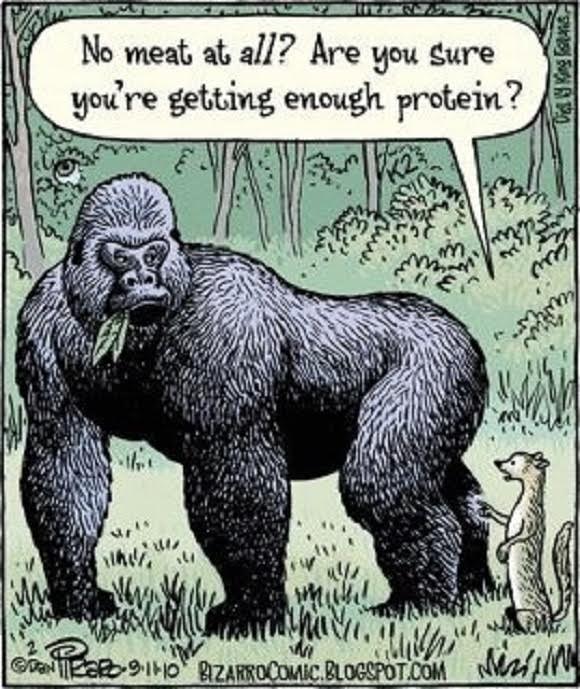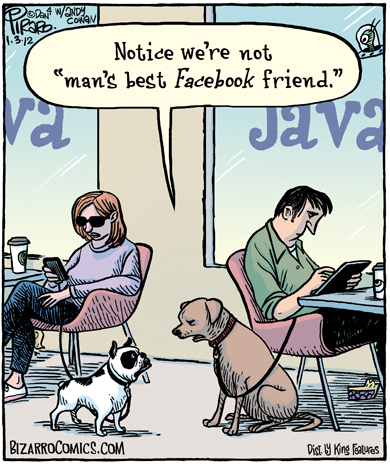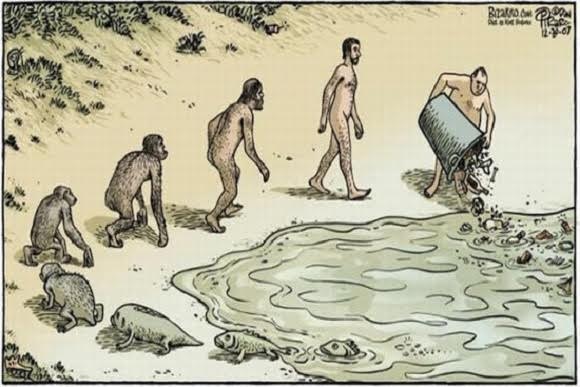
Dan Piraro: ‘I became known as a cartoonist who does animal rights stuff’
It’s hard to imagine this ad:
HELP WANTED: Talented cartoonist needed for newspaper gig. Self-starter. Must be able to generate a new single-panel comic every day, including Sunday. Each comic must feature striking, sometimes incredibly detailed artwork, often involving surrealistic imagery. The panels should incorporate social commentary, a great deal of word play, a strong and recurring animal presence, with many of the comics reflecting animal rights themes.
One reason this ad may be hard to imagine is this position has been filled—and the job deftly performed–for more than 30 years by Dan Piraro, who draws the widely syndicated comic “Bizarro.”
He is an acclaimed artist, having racked up a string of awards and honors—including, notably, amongst his peers: He won an unprecedented three consecutive “Best Newspaper Panel” awards from the National Cartoonists Society, and the National Cartoonists selected him “Outstanding Cartoonist of the Year” in 2010.
A video profile of ‘Bizarro’ cartoonist and animal rights activist Dan Piraro
Readers feel the same way. Over his three decades drawing the panel, Piraro has built a fiercely loyal following, and at a time when newspapers have shrunken or died, “Bizarro” appears in 350 papers.
So when he announced on his blog in late May that he would be quitting the job, it caused quite a stir.
An uproar, really. Given the decided animal orientation of “Bizarro,” you might say this news prompted the Piraro partisans to go ape.
A few days after delivering this earth-shaking announcement, which also appeared on Piraro’s Facebook page, the cartoonist recalled the whole episode in a Talking Animals interview.
“Yeah, I mentioned that after doing ‘Bizarro’ 365 days a year for 30 years, I was going to be retiring it,” Piraro, 57, explained. “Not retiring from life, and not retiring from art, but just retiring from ‘Bizarro.’ I want to try to segue into doing more fine art, the kind of stuff that doesn’t have strict deadlines, and doesn’t have punch lines involved.
“I was mentioning that by way of opening up a new store section on Bizarro.com, where you can buy everything from prints of my ‘Bizarro’ cartoons to the original art of my ‘Bizarro’ cartoons. But also some other kinds of fine art—from large, expensive oil paintings down to small, relatively inexpensive little sketch cards that I’ve drawn, to these strange, stream-of-consciousness images.
“So that was basically what I was announcing. But”—he laughed heartily here—“at first, I didn’t exactly make it clear that when I said I would be retiring from ‘Bizarro,’ I was not talking about immediately—I was talking about two or three years from now. And some people got all ‘Oh, no, you’re gonna be gone…Well, goodbye and good luck’
He laughs again, and then picks up the thread of the story where he realized he needed to quell the uproar by setting the record straight, pronto.
A Dan Piraro video in which a pig explains why eating meat is bad for you…
“Yeah, I clarified it,” he said, “putting out another post right away saying ‘I didn’t mean I was leaving right now! I meant in a couple or three years. So there’s still some time. I will still be doing this on a daily basis for some time, so don’t stop coming to the blog or looking in the newspaper for my work, and it will still be there for a couple-three more years.’ “
Piraro lamented that in the hubbub triggered by the I’m-winding-down-“Bizarro” portion of his announcement, the other key messages—that he was creating a new online store and, on a very related note, he was revealing his semi-secret identity as a fine art painter—got rather short shrift.
But he seemed philosophical about this, taking the long view about veering onto a new path as he zooms along in his career journey, and optimistic about “Bizarro” fans climbing aboard.
“Part of announcing my eventual exit from the cartoon world was to build a certain kind of urgency,” he said. “In fact, I don’t draw cartoons on paper any more—I draw them on computer. Literally, ‘Bizarro’ cartoons have already stopped being produced, in terms of what you could own yourself. So it’s a finite supply, which makes them more valuable.

“And there has been a pretty good response to that. I have been selling a lot of art in the last few days. For the last few years, people have been buying more of my art.
“Let’s face it: I’m looking to end my ‘Bizarro’ income in just a few years, so I’m trying to build up another source of income. Unlike [“The Far Side” cartoonist] Gary Larson and [“Calvin and Hobbes” cartoonist] Bill Watterson, I’m not so wealthy that I can retire and never look back, without another job.
“I’m actually a working stiff, like most people. I make a decent living, but I can’t just afford to stop working and retire. I have to replace my income. So I’m looking to build up a large clientele of people who would like to buy interesting, original art. So I would do that with my days, instead of chasing deadlines for another 30 years.”
The more Piraro and I chatted about it, the more it appeared his decision had been driven by a blurry blend of multiple motivations.
Trying to sort this out, I asked if the decision was owing to having drawn “Bizarro” for 30 years, and 30 years is a long time to do anything?
Or, is he artistically unsatisfied, maybe a little bored?
Or, does he want to do other things in his life, and want to bridge to a point where he can do them?
“Yes!” Piraro laughs long and loud.
Yes to all of them?
“Exactly,” he said. “It’s all of those things. I get bored very easily, and I think creative types have that. We just tend to get bored with routine more easily than others.
“I’m surprised that I’ve been able to do this for 30 years. It’s not hard to draw a cartoon every day. What’s difficult about the job is to think up a joke, think up an original joke every day for 30-something years. It’s a difficult task.

“Within syndication, of the sort that I have, there’s no vacation. You can’t take time off because you have the flu or your dog died, or any other reason. The work’s got to be there because you have however many client newspapers, and they’re all expecting new work.
“Every week, they expect a week’s worth of new cartoons, because that’s what they contracted for, and there’s just no time off.
“To get time off, you have to work double hard for several weeks. And, again, it’s hard enough just to draw twice as much work.
“But to actually think up twice as many clever ideas in the same amount of time, it’s just tough. It’s tough–a creatively and intellectually demanding schedule.
“So, yeah, I am tired of it. Yes, I would like to be able do things that are more interesting to me. And the third part is that I just don’t have time. I would love—since I was a kid, I was programmed to be an artist. I wanted to be a fine artist, but I couldn’t figure out how to make that lucrative early in my life.
“I got the idea to be a cartoonist. That seemed to work out, I’ve made a nice living, and I’m certainly not complaining.
“But it’s never what I wanted to do. What I wanted to do was be an artist, just create interesting art.”
Of course, “Bizarro” devotees—apparently a passionate, populous congregation—would likely argue that Piraro has already been creating interesting art. For three decades.
And it’s not all that difficult to understand his professional restlessness. That’s hardly uncommon. A decade or two in, a great number of us have pondered changing careers, and many have actually made a switch.
But working as a syndicated newspaper cartoonist is sufficiently esoteric that the profession itself is hard to understand.
So I asked Piraro to walk me through a typical day, or week—to describe how, exactly, he satiates the relentless gob impatient to be fed with yet another freshly drawn “Bizarro.”
“I get up in morning, and I’ll get online the first hour of the day, reading articles,” he explained, embracing the idea of delivering a detailed account of his workday. “I will glance at my email, just to put out fires, but I don’t really want to get deep into email because I’m looking to keep my headspace time clear, so I can write some gags—before my brain gets polluted with facts, facts of my life, things that people want of me.
“So I kind of tend to stay away from email first thing, and I’ll read some newspaper articles and I’ll go around and do one thing or another on the web, and I’ll try to come up with gag ideas. One, two, three a day—just something.
Dan Piraro shares several cartoons considered too controversial for his nationally syndicated comic strip ‘Bizarro,’ including a theory on why dinosaurs do not appear in the Bible and a speculation on how religious iconography might be different if Jesus had died in an electric chair, instead of on a cross.
“Some days you get four, some days you get nothing. And it all evens out eventually, and I just scribble them down in very quick form. And then, later, after that’s done for an hour or two, then I go back and hit my emails. And that takes me a couple of hours, just to sort out all the people who want one thing or another. We all have that in our lives. Email is both a curse and a blessing.
“And then there’s people who want reprints. I get an awful lot of people saying ‘I remember a cartoon once that had this, this and this. Was that yours? And if so, can I get a copy of it?’ And then I think ‘I think that’s mine,’ and it’s an archive situation…
“So by this time, it’s almost noon, and I’m really doing so far is clerical stuff, I’m trying to write cartoons and I’m trying to catch up on emails. Then I start actually drawing, knocking out a week’s worth of cartoons, so I look through all of my notes from all the things that I’ve written over the past days or weeks or months, and I try to find seven good candidates for a week’s worth of cartoons.
“And once I decide on that, then I start dropping in the captions—I used to work on paper, now I work entirely on computer. So I open up the program I use, and I start dropping in the captions and I start drawing, and that takes a couple of days.
“Then, when that’s done, it’s all got to be colored. Meanwhile, once a week, I write my blog, and I post that. Then I have to answer comments on the blog.
“It’s just one thing after another. And there’s always [in addition to all this] some sort of sideline thing: ‘We’re going to put out a book,’ so I’ve got to do some kind of extra art work for that. Which means I’ve got X number of weeks to finish the cover for the next book.
“Or a greeting card company writes and says, ‘We’d like to have these four images, and these eight new images for the greeting card line.’ So I’ve got to reformat those, and send those out to them, hi-res, in the way that I know they like it. So it’s always something. It really does become a seven days a week job.
Excerpts from The Bizarro Baloney Show with Dan Piraro
“I work at home, and I love working at home. But the bad thing is that you can never leave the office. If I’m at home, I feel like I should always be working on something right now—I should be catching up on some of this stuff. I literally work seven days a week.
“I kind of hate to talk about, because it sounds like I’m complaining. I have a dream job. So I do want to make sure that people know that I’m very grateful for the opportunities I’ve been given to do this. But you can only do the same thing for so long before it drives you nuts.”
Granted, 30 years is a long time to do the same thing, especially when that same thing involves the grueling routine he has detailed here.
But one major running element of “Biarro” cartoons that has been present from day one yet it’s safe to say neither cartoonist nor reader has grown tired of: animals.
Indeed, animals—often talking animals…talking to a shrink, talking to other animals, talking to humans—have formed a core constituency of the Piraro oeuvre.
From the get-go, “Bizarro” has reflected a palpable affection for animals, a kinship for critters of all stripes (sometimes literally). “Yeah,” he said, “I have always been sympathetic and compassionate to animals, since I was a kid,”
Beyond that fundamental modus operandi, about a dozen years ago, the strip began radiating a more explicit empathy, with animal rights concerns and themes coursing through many of the cartoons.
Addressing this tangible shift in the “Bizarro” content, Piraro begins with an unexpected biographical detail.
“When I was a kid, my Dad occasionally brought me hunting, bird hunting,” he said. “And my Dad had a high sense of ethics about that: ‘You don’t ever shoot anything that you’re not going to eat.’ So he wasn’t one of these yahoos who’d go out and ‘Let’s kill something’ and start shooting away. He was very much ‘It’s within the law, you go after the ones that are in season, and large enough” and so on.
He went on to provide a further glimpse into the psychology of these outings, explaining that his father was a workaholic who wasn’t around the house much when Piraro was growing up (“a typical 1960s, Mad Men Dad, he was at the office a lot”), so the activity itself was immaterial.
“I didn’t get too much time to spend with my Dad, so when I got the chance, I thought it was great. But at the same time, it would make me feel bad… I just felt bad for the birds that we were shooting. There was something about it that broke my heart. Of course, as an adult, I never went hunting again.
He paused for a moment, then continued: “I know that we animals rights folks tend to really despise hunters, but there are a lot of hunters that have that very same sort of code [my Dad did.]
“They believe that there is a respectable way to take food from nature, and an unethical and wrong way to do it. Quite honestly, I do not think that hunters are the biggest problem, when it comes to animal cruelty—factory farms are far more cruel than any hunter could be.”

Spoken like a true convert—animal rights activist, and the overlapping conversion to veganism, which took place in 2002, when he was dating his now ex-wife Ashley Lou Smith, who had been a vegan since her teen years.
That conversion and the ensuing enlightenment about a host of animal issues—factory farming foremost among them—crept into the “Bizarro” world.
“It was a natural progression from things I was thinking about,” he recalled. “So I ended up writing jokes about them, and put them in the cartoon. I became known as a cartoonist who does animal rights stuff
“There’s never been entirely my focus—there’s never been a time when I’ve sat down to write animal rights jokes. It’s just on my mind, so it comes out.”
But it’s only going to come out that way for about two more years.
Maybe three.
Click here to listen to the May 27 Talking Animals, featuring the interview with Dan Piraro

About the Author: Duncan Strauss is the producer-host of “Talking Animals,” which he launched at KUCI in California in 2003, combining his passions for animals, radio, journalism, music and comedy. The show has aired since late 2005 on Tampa’s WMNF. Strauss lives in Jupiter Farms, FL with his family, including four cats, two horses and one dog. He spends each day talking to those animals, and maintains they talk right back to him, a claim as yet unverified.

